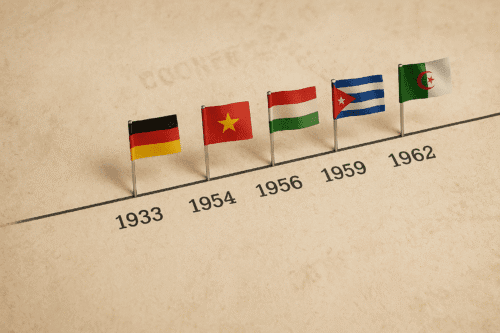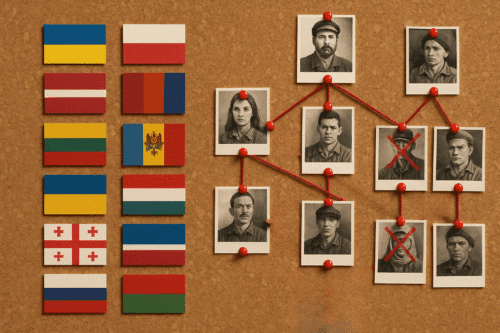
Assessing Revolutionary and Insurgent Strategies (ARIS) is a U.S. Army–sponsored research program that compiles historical case studies and analytical frameworks on insurgency, resistance, and irregular warfare. Built on the foundation of earlier Special Operations Research Office (SORO) work, ARIS provides military professionals, policymakers, and scholars with accessible, rigorously documented insights into the dynamics of undergrounds, revolutionary movements, and counterinsurgency.
Undergrounds in Insurgent, Revolutionary, and Resistance Warfare (2nd Ed)
Undergrounds in Insurgent, Revolutionary, and Resistance Warfare analyzes the organization, security, and operations of underground movements, offering insights into how clandestine networks sustain resistance over time.
Human Factors Considerations of Undergrounds in Insurgencies (2nd Ed.)
Human Factors Considerations of Undergrounds in Insurgencies explores the psychology, recruitment, and group dynamics that drive individuals to join and remain active in underground movements.
Legal Implications of the Status of persons in resistance
The Legal Status of Participants in Irregular Warfare examines how insurgents, partisans, and civilians are classified under international and domestic law, clarifying their rights, risks, and obligations.
Threshold of Violence
Threshold of Violence examines how and why resistance movements transition from nonviolent protest to armed struggle, analyzing the factors that influence the decision to resort to violence.

Science of Resistance
The Science of Resistance explores why resistance movements emerge, how they organize, and what factors shape their strategies and outcomes. It provides a framework for understanding resistance across a spectrum from nonviolent action to armed struggle.
Resistance and The Cyber Domain
Resistance and the Cyber Domain examines how resistance movements use cyberspace for communication, organization, and influence while also facing new vulnerabilities, offering insights into narratives, security, and the evolving role of cyber operations in irregular warfare.
Understanding States of Resistance
Understanding States of Resistance develops a phasing framework to explain how resistance movements emerge, grow, and decline, integrating insights from law, economics, and political science to analyze their progression and outcomes.
Understanding Resistance
Understanding Resistance introduces key concepts for analyzing contemporary resistance, from phases of mobilization to legitimacy, external influence, and the transition from movements to governance, providing Special Operations Forces with conceptual tools for assessment.

The Day After Overthrow: How The Behavior of The State and The Resistance Shapes Post-Overthrow Outcomes
The Day After Overthrow examines 69 cases of state overthrow since World War II, analyzing how the behavior of both governments and resistance movements shapes post-transition outcomes, from recurring civil war to stable governance
Resistance Manual
The Resistance Manual provides a comprehensive guide to resistance theory, organization, and dynamics, integrating insights from political science and history to explain how movements form, sustain themselves, and adapt under pressure.
Resistance Pocket Guide
The Resistance Pocket Guide distills key concepts of resistance, insurgency, and unconventional warfare into a compact reference for military leaders and planners, emphasizing doctrine, phases of resistance, and critical factors for success

Case Studies in Insurgent, Revolutionary & Resistance Warfare

Casebook on Insurgency and Revolutionary Warfare Vol I (1933-1962) Revised Ed.
A survey of insurgent and revolutionary campaigns from 1933 to 1962, capturing early organizational patterns, strategies, and the influence of external actors.

Casebook on Insurgency and Revolutionary Warfare Vol II (1962-2009)
An examination of insurgencies from 1962 to 2009 across multiple regions, analyzing Cold War and post–Cold War dynamics in shaping movements and outcomes.

Case Studies In Insurgency & Revolutionary Warfare: Fostering Effective Counter Unconventional Warfare/Occupation
A study of resistance against Soviet and Russian aggression, distilled into lessons for designing counter–unconventional warfare strategies and national resilience.

The Rhodesian Insurgency and The Role of External Support: 1961-1979
A case study of the nationalist insurgency against white minority rule, focusing on ZANU and ZAPU and the influence of competing Soviet and Chinese support.

Columbia (1964-2009)
A case study of Colombia’s long insurgencies, examining the origins, structures, and strategies of groups such as FARC, ELN, M-19, and AUC, alongside government countermeasures and lessons for future conflict.

Guatemala (1944-1954)
A study analyzing Guatemala’s revolutionary period, detailing political, social, and military factors that contributed to instability and regime change.

Sri Lanka (1976-2009)
A study of the protracted conflict between the Sri Lankan state and the LTTE, analyzing insurgent strategy, government responses, and the factors leading to the war’s conclusion.

Algeria (1954-1962) Revised Edition
A case study of the Algerian War of Independence, highlighting FLN insurgent methods, French counterinsurgency measures, and the role of population mobilization.

Greece During World War II
An examination of the Greek resistance to Axis occupation, focusing on guerrilla operations, competing factions, and the impact on liberation and postwar politics.

Cuba (1953-1959)
A case study of the Cuban Revolution, tracing the rise of Castro’s insurgency against Batista and the strategies that enabled its victory.

The Patriot Insurgency (1763-1789)
An analysis of the American Revolution as an insurgency, highlighting organization, foreign support, and the transformation of colonial resistance into independence.

The Relationship Between Iran and Lebanese Hizbollah
A study of the strategic, financial, and operational ties linking Iran with Hizbollah, underscoring the network’s role in regional unconventional warfare.

The Assessing Revolutionary and Insurgent Strategies (ARIS) publications are official U.S. Government works produced under the sponsorship of the U.S. Army Special Operations Command. As such, they are in the public domain and may be freely accessed, reproduced, and distributed without restriction.
All ARIS volumes available here were formally released for unlimited public distribution through U.S. Army channels and repositories. No classified or sensitive information is included. The materials are presented for historical and educational purposes only, and their availability does not imply endorsement of any specific viewpoint, strategy, or application.
Users should note that while ARIS reports analyze insurgency, resistance, and irregular warfare, they do so from an academic and historical perspective. Nothing contained in these works should be interpreted as instruction or advocacy for unlawful activity.
